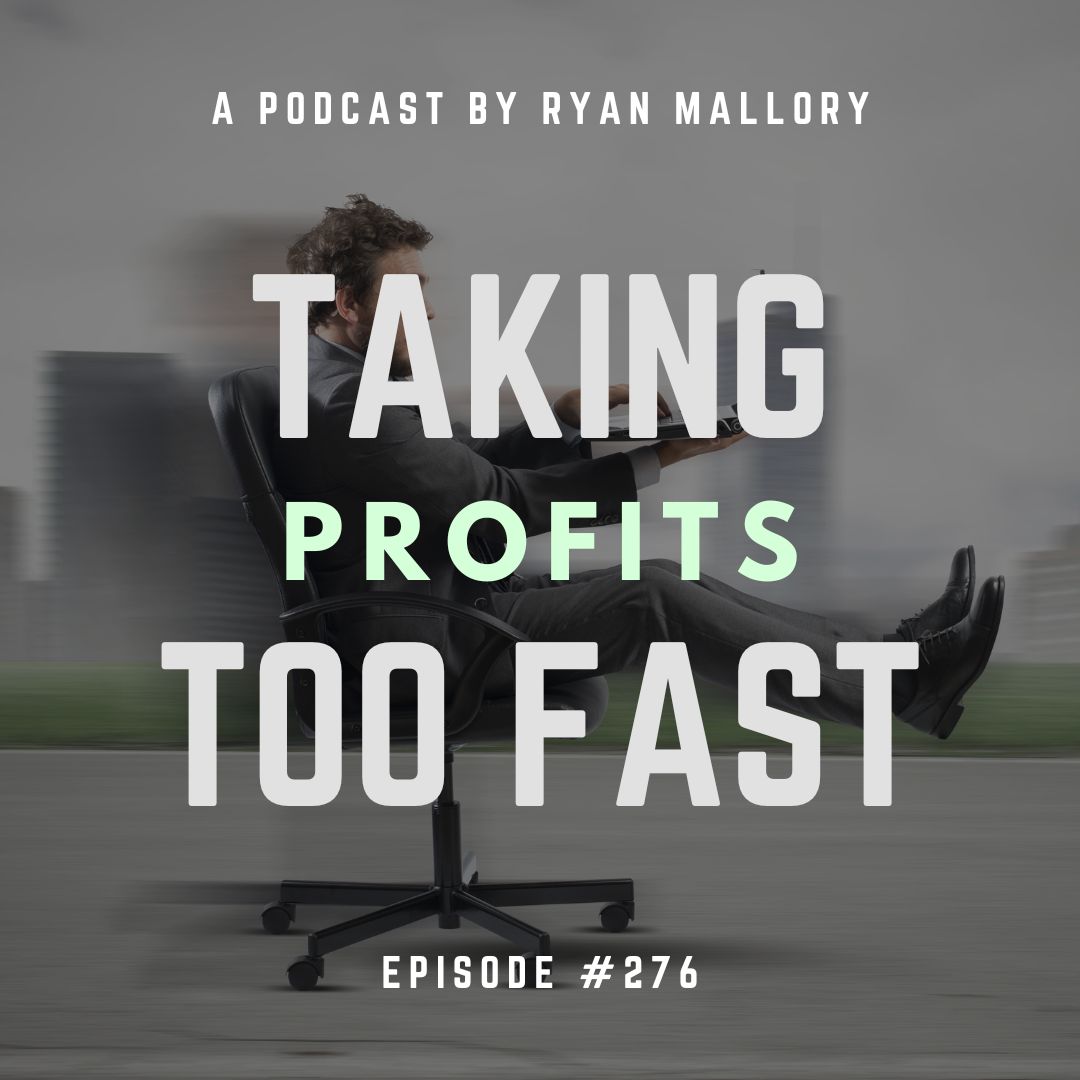Episode Overview
One trader, with a small account continues to struggle with cashing out his winning trades too quickly rather than letting them run. How can this trader ignore the temptations of booking small profits and instead position himself for the much bigger winning trade?
Available on: Apple Podcasts | Spotify | Amazon | YouTube
Episode Highlights & Timestamps
- [0:07] Introduction
Ryan kicks off the episode by introducing a listener email from Burt, a new trader who consistently sells too early and wants to know how to break that habit. - [1:23] Placing Better Stop Losses
Burt shares that he understands the importance of raising stop losses but doesn’t know how to identify support levels when they are forming. - [4:30] The Real Issue: Fear of Losing
Ryan explains that the habit of taking profits too quickly is more about ego and the fear of being wrong than about making money. - [6:26] You Can’t Force Trading Success
Why traders should stop trying to force wins and instead embrace the learning process, accepting losses along the way. - [10:00] Support Levels Must Be Established
Ryan emphasizes the importance of waiting for a support level to fully develop before using it to adjust stop losses.
Key Takeaways from This Episode:
- Fear of Losing Hurts Performance: Taking profits too quickly is often about avoiding losses rather than maximizing gains.
- Stop Anticipating Support Levels: Only adjust stop losses when a clear, developed support level is in place, not before.
- Smaller Wins Can’t Offset Small Losses: Capturing 0.5% gains while risking 2% creates a flawed reward to risk ratio that will hurt over time.
- Ego is the Enemy: The desire to always be right in trading leads to emotional decisions and early exits.
- Focus on Process, Not Profit: For small accounts, the goal should be to learn and develop consistency, not to turn $250 into riches overnight.
Resources & Links Mentioned:
- Swing Trading the Stock Market – Daily market analysis, trade setups, and insights by Ryan Mallory.
- Join the SharePlanner Trading Block – Get real-time trade alerts and community support.

Take the Next Step:
✅ Stay Connected: Subscribe to Ryan’s newsletter to get free access to Ryan’s Swing Trading Resource Library, along with receiving actionable swing trading strategies and risk management tips delivered straight to your inbox.
📈 Level Up Your Trading: Ready for structured training? Enroll in Ryan’s Swing Trading Mastery Course, The Self-Made Trader, and get the complete trading course, from the foundational elements of trading to advanced setups and profitable strategies.
📲 Join the Trading Community: Sign up for SharePlanner’s Trading Block to become part of Ryan’s swing-trading community, which includes all of Ryan’s real-time swing trades and live market analysis.
Full Episode Transcript
Click here to read the full transcript
0:07
Hey, I’m Ryan Mallory and this is my swing trading the stock market podcast. I’m here to teach you how to trade in a complex ever-changing, world of Finance, learn what it means to trade, profitably and consistently managing risk, avoiding the pitfalls of trading. And most importantly, to let those winners run wild, you can succeed at the stock market and I’m ready to show you how?
0:30
Hey, everybody, this is Ryan Mallory with swing trading the stock market and today’s Episode. We’re going to hear from a guy that’s just taking profits way too fast. He wants to know what he can do different, how he can prevent that from happening in the future and that’s what we’re going to focus on.
0:46
So for this email today, we’re going to call this guy Burt. Good old Florida red, nickname Burt and Burt says very new Trader. Here, I have a hard time letting my winners keep riding. Once I have a stock go into the green, I immediately want to sell, even at point five percent, I’m only trading with a 250 dollar account, so I’m not risking more than I can afford. Or anything like that, really trying to learn the process for a while before adding Capital smart move. I’ve been disciplining myself with tight, stop losses. And then trusting the analysis, I did to start the trade, but I still want to sell as soon as I see the stock go up because I want to capture those games right away rather than risk losing them.
1:23
I hear you talk a lot about taking some profits along the way which definitely helps lower my desire to sell the whole position. You also mentioned placing new stop losses at a higher key support level my Is how do you recognize a key support level when it is developing? I think if I knew when and how to place the stop loss, he wrote that in kept, by the way. That’s why I was trying to emphasize it because I felt like you was trying to emphasize it. If I knew the win and how to place the new stop losses, I would be more comfortable letting the winners ride. Thank you for your podcast and Patron Services. Thank you Burt. All right. Burt, we’re going to get to your question just a second.
2:00
But first, what am I drinking? I am drinking black and, but it’s not just any black and like I’ve done. In the past, which by the way, is a really good bourbon. One of my favorites, but this black and is mixed or Blended. I guess. Is the correct term with? Will it? So we’ll, it’s not bad.
2:16
If you don’t get the one that looks like a bong, it’s the one that looks like it’s in a normal bottle. Like, with a green label or with a Purple Label, those are good. The one that’s shaped like a bong taste. Like you’re munching your way through a flower patch and it’s just absolutely disgusting. But the higher end will it’s a really good don’t fall for the fancy bottle.
2:34
Will it that? Literally looks like it came from a bong Factory. Okay, so this one’s 54.8% alcohol, which makes it a hundred 9.6 proof, color looks nice and light. It’s a brown color. It’s not like the pissed.
2:50
Toilet water color, it’s a light brown into the nose. It has like a pretty good brown sugar flavor like a very strong one to to The Taste man picking up on some serious caramel flavors and then the finish the Finish is kind of interesting because it does come with a Little bit of a kick but it’s nothing serious.
3:07
But you got this like buttery like cinnamon flavor. As a finishing taste, it’s not bad. It’s kind of a different finish for sure, but the crazy thing about this is it’s got 154 dollar bottle price. Not, did I pay that heck no, I got a sample so I’m not paying that.
3:26
I would never pay a hundred fifty four dollars for this bottle. It’s just isn’t worth it to me. It doesn’t make it necessarily A Bad Bourbon. I just think it’s poorly priced and I think they’re trying to capitalize on the name. Will it but scale of 1 to 10? It’s hard to rate this thing to hide just because if you’re going to charge $154, I think better come out swinging and I just don’t think it gives you enough of that like excitement to Warrant a real high score.
3:52
So if it was say like a 40 dollar bottle easily, this one could be at every day sipper maybe even like a chill weekend sipper but $154 you can’t afford to sit that stuff every day. So I’m gonna give it a seven point nine. It’s about as high as I can go. I just can’t give this thing anything over an eight so 7.9, that’s what we’re going with now.
4:11
Bert has a good email here and this plagues a lot of Traders man. I see it with a lot of people I see with friends all the time where they’ll plan out the trade and everything but then they take profits fast. And so I’m really trying to figure out where Bert’s going with this one because he’s trading with $250, right?
4:30
Nobody likes to lose $250 entree, I don’t want to lose $250 on a trade. There’s a lot you can do with $150 like go to McDonald’s. I mean McDonald’s I think the number three now is $250, but he tells you right in the email. I’m not risking more than I can afford to lose or anything like that, and he’s trying to learn the process of swing, trade learning, how to do that whole thing.
4:49
But then when he gets up, he’ll take profits at, like, a half percent. So if it’s not necessarily like a meaningful amount of money, why is he treating it? Like it is like, why is he taking profits? Like he’s afraid to lose and that’s where I think what it actually is. I think it’s not so much the money that He’s trying to make.
5:06
I think it’s a fact that he can’t willingly lose on a trade. So that’s not a good place to be. That’s like ego talking right there. So, fear of losing place to your ego and eventually the markets going to knock down that ego something. But you have to be willing to lose in the stock market and you guys listening to me for any length of time, know that I’ve said that quite a bit, you’re going to lose.
5:25
You’re going to lose a lot. And if you do this for 10 15, 20 years, you’re gonna have a lot of losing trades. You’re gonna have some humiliating traits and even some of those humiliating trades will come on the cusp of being a good risk. Manager of managing the risk, consistently the just happens and trading, but you have to strip yourself of that ego.
5:41
You have to be willing to lose, and I have to be okay with losing. You can’t let it be one of those things to where, every time you take a loss, you try to do the exact thing on the next trade that, you think you should have done on the previous trade, like, man, I sold too early, I’m not selling early again, so then you hold it too long. Or if you held it too long ears, like I’m going to be much more aggressive on the prospect taking its on the next trade you’re too aggressive in the thing takes off, you don’t want to just kind of have these knee-jerk reactions to One of your trades.
6:06
Instead, you want to look for Trends in areas where you can improve and consistently and I believe Burt when he says that, you know, he’s not playing with an amount of money that is going to be detrimental to him if he loses it all. And that’s why I really think that it’s more about winning and losing to him rather than paying the dues and taking the time to become a good Trader, you can’t force success in the market.
6:26
You can continue to increase your knowledge base to continue to gain experience, but you can’t force success. Most people, when they get into the stock market. They want to force the success. They want to be great right out of the gate that rhymed. But the sad part is, is that usually the mentality that causes us to leave the markets early before we actually have a chance to see our full potential as a Trader, because when we don’t have that success, initially, we just say to ourselves.
6:51
It’s not for me or the markets rigged, or I can’t do this, I’m going to find something else to do and then they buy something that’s probably worse than anything, they could have done in the stock market, but the issue of taking If it’s too soon especially when you’re taking like half percent or 1 percent gains and you’re setting your stop losses at.
7:12
Let’s say you’re setting them at two percent within you’re in a situation a small losses that will outpace even smaller rewards. And so we go back to the reward risk ratio. What does that tell you? Is I tried to at least double what you’re willing to risk on a trade. So, if I’m taking a 3% risk on the trade, I’m going to try to aim for that like 6%.
7:29
I want to trade setup work. It’s feasible to be able to pull out of it or extract from the trade a single. Percent profit. If it’s a four percent stop loss than 28 percent profit. Ideally, it should be about three, two one. Sometimes in a bear Market that can be a little bit more difficult because let’s face it, the lowest the stock can go is 0, so you can’t just write it into Infinity like you can a winning trade.
7:52
So when I’m sure in the market, I’m looking more for that 2 to 1 return. In most cases, that doesn’t mean I don’t come away with a three to one return on some of my short setups. But my aim is to get a 2 to 1 return, someone because the markets will sell off and then they’ll immediately Bounce, there’s this propensity to buy the dip to try to create these dead cat Bounce has that you don’t really see the inverse of in a bull market.
8:14
I would maybe even say this maybe even well me back up a little bit. I think Burt. Here is probably putting all $250 on one single trade. That would be my guess because most people are going to because it’s only $250. I mean there’s a lot of stocks that trade well over two hundred fifty dollars, a share.
8:30
So if he was the trade like $50 on each trade, it wouldn’t be necessarily. Most exciting thing in the world from a dollar standpoint because if you made five percent on a fifty dollar trade, he’s essentially making like, 250 right. But I also tell people to don’t get caught up in the dollars especially when you’re starting off trading with like let’s say $250 don’t even worry about that stuff.
8:51
Yes $250 like I said earlier, it’s still important but don’t think you’re going to get rich off of that because you’re not, I mean you have to get into some crazy penny stock that just completely went crazy and penny stocks are absolutely dangerous. You have A thousand times of a better chance of losing everything, and a penny stock than you do having even make a dollar in the penny stock market, probably, but maybe even cut exposure, if you’re doing your full position size with your entire account, maybe cut it down to $125 and just see how that works.
9:23
And also what works is Swing trading, the stock market.com. Yes, this is my Patron website that I referred to often times it supports the podcast. When you join, you’re going to get all my stock market research each and every day, I’m sitting out multiple videos. Watch list. I’m sitting out updates on Tech. I’m sitting out updates on all the major indices, giving you the stocks that I’m looking at each day as well as different trade ideas.
9:45
Check that out swingtradingthestockmarket.com by becoming a member. You’re also supporting this podcast so I appreciate it quite a bit. So is actual question on a podcast and we haven’t even got to that from Bert is, my question is, how do you recognize a key support level when it is developing?
10:00
I think if I knew when and how to place the new stop loss, Boss. I would be more comfortable letting the winners. Right. Well, there’s an interesting word that he uses. There is developing when a support level is developing. I don’t care about it developing. I want it to be developed.
10:16
I wanted to be there already. I’m not going to anticipate the support level. I’m going to wait for it to be developed and work it, then you don’t want to anticipate support levels. You don’t want to say, well, it could end up bouncing right here and creating a new support level, but there’s really no support level. There are no basis for thinking that it’s going to bounce there.
10:33
You want to wait for it that support level to We be created and then when there is a definitive support level, then when that stock is moving higher, I’ll raise my stop-loss below that key support level. So there is a lot that we covered in. This podcast went a little bit shorter than I was expecting. But remember don’t try to for success in your trading.
10:51
If you do it you’re more than likely going to take on unnecessary losses. And the fact that he’s taking half percent gains tells me that he’s probably struggling with the fact that he doesn’t want to come away, a loser on the trade and doesn’t make you a loser. Just means you have to lose. Seeing trade, we’re going to have losses and trade.
11:07
You got to get used to it and it doesn’t reflect on you being a bad traitor especially for those who are trying to for success. I think those are misplaced perceptions on what trading is about. You’re going to have losing trades. That doesn’t necessarily negate you from becoming a successful Trader down the road, but it’s definitely not going to happen.
11:24
Right out of the gate. Can’t be afraid of losing money. You can’t be afraid of losing trades. As long as you’re planning out the trades a long as you’re planning for the risk, and you’re following your plan, and you’re keeping the risk tight. When you start fearing, Losing your plane to Your Ego, your play into the desire that I can’t afford to lose and you don’t want to be in that situation.
11:41
So you got to strip yourself of your ego and remember if you were taking profits far too quickly. That means you’re putting yourself in a situation where smaller losses will outpace even smaller rewards. So that’s going to do it for this one. You guys have any questions, make sure it’s send me e-mail at ryan@shareplanner.com.
11:57
Make sure to leave a five-star review. To, I’ve been reading the stuff that you guys have been leaving lately. I do appreciate it. I appreciate it a lot actually. I saw some reviews. Choose from lean thin. Appreciate his kind words also from gesture dcv. Those are awesome as well, makes me really happy to see some of those kind reduced corn in.
12:14
So, thanks again. And God bless. Thanks for listening to my podcast. Swing trading the stock market, I like to encourage you to join me in this SharePlanner trading block, where I navigate the stock market. Each day with Traders from around the world with your membership, you will get a 7 day trial and access to my trading room including alerts via text email.
12:34
And what’s So go ahead, sign up by going to shareplanner.com trading block, that’s www.shareplanner.com/trading-block. And follow me on SharePlanner’s, Twitter, Instagram, and Facebook, where I provide unique market and trading information.
12:49
Every day you have any questions, please feel free to email me at ryan@shareplanner.com all the best to you and I look forward to chatting with you soon.
Enjoy this episode? Please leave a 5-star review and share your feedback! It helps others find the podcast and enables Ryan to produce more content that benefits the trading community.
Have a question or story to share? Email Ryan and your experience could be featured in an upcoming episode!
Become part of the Trading Block and get my trades, and learn how I manage them for consistent profits. With your subscription you will get my real-time trade setups via Discord and email, as well as become part of an incredibly helpful and knowledgeable community of traders to grow and learn with. If you’re not sure it is for you, don’t worry, because you get a Free 7-Day Trial. So Sign Up Today!

Welcome to Swing Trading the Stock Market Podcast!
I want you to become a better trader, and you know what? You absolutely can!
Commit these three rules to memory and to your trading:
#1: Manage the RISK ALWAYS!
#2: Keep the Losses Small
#3: Do #1 & #2 and the profits will take care of themselves.
That’s right, successful swing-trading is about managing the risk, and with Swing Trading the Stock Market podcast, I encourage you to email me (ryan@shareplanner.com) your questions, and there’s a good chance I’ll make a future podcast out of your stock market related question.
In this podcast episode Ryan talks about not allocating all of your capital to one single trade. He covers why it is dangerous to your trading and the sustainability of that strategy long-term. Also covered is how much should you dedicate to long-term vs short-term trading, and whether you should ditch one approach for the other.
Be sure to check out my Swing-Trading offering through SharePlanner that goes hand-in-hand with my podcast, offering all of the research, charts and technical analysis on the stock market and individual stocks, not to mention my personal watch-lists, reviews and regular updates on the most popular stocks, including the all-important big tech stocks. Check it out now at: https://www.shareplanner.com/premium-plans
📈 START SWING-TRADING WITH ME! 📈
Click here to subscribe: https://shareplanner.com/tradingblock
— — — — — — — — —
💻 STOCK MARKET TRAINING COURSES 💻
Click here for all of my training courses: https://www.shareplanner.com/trading-academy
– The A-Z of the Self-Made Trader –https://www.shareplanner.com/the-a-z-of-the-self-made-trader
– The Winning Watch-List — https://www.shareplanner.com/winning-watchlist
– Patterns to Profits — https://www.shareplanner.com/patterns-to-profits
– Get 1-on-1 Coaching — https://www.shareplanner.com/coaching
— — — — — — — — —
❤️ SUBSCRIBE TO MY YOUTUBE CHANNEL 📺
Click here to subscribe: https://www.youtube.com/shareplanner?sub_confirmation=1
🎧 LISTEN TO MY PODCAST 🎵
Click here to listen to my podcast: https://open.spotify.com/show/5Nn7MhTB9HJSyQ0C6bMKXI
— — — — — — — — —
💰 FREE RESOURCES 💰
My Website: https://shareplanner.com
— — — — — — — — —
🛠 TOOLS OF THE TRADE 🛠
Software I use (TC2000): https://bit.ly/2HBdnBm
— — — — — — — — —
📱 FOLLOW SHAREPLANNER ON SOCIAL MEDIA 📱
*Disclaimer: Ryan Mallory is not a financial adviser and this podcast is for entertainment purposes only. Consult your financial adviser before making any decisions.





